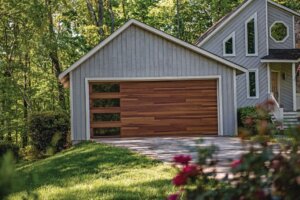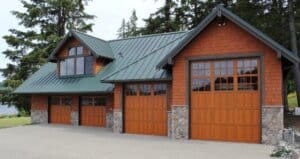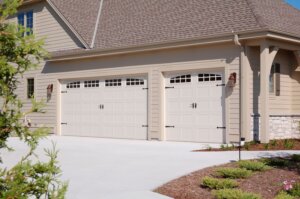
Standard Garage Door Sizes
Common Garage Door Sizes for Homes
Whether you’re designing and building a new home or looking to replace an existing garage door, it’s important to understand garage door sizing. It can be difficult to standardize a garage door given the variety in size combinations, but some sizes are certainly more common than others.
Garage Door Design Options (New Construction vs Existing)
If you’re designing a home, keep in mind that selecting a standard size garage door will likely keep the price and lead time down compared to a custom garage door. Before you finalize your garage door size, ask yourself a few questions. This list is not exhaustive but will give you a head start on garage door planning.
- Will my current or expected vehicle fit in the garage?
- What type of garage storage system will I use?
- How tall are my garage ceilings?
- Does my HOA have requirements/restrictions for garage doors?
If you bought an existing home, the garage door size is likely fixed. Reframing a garage door opening for a custom garage door can be expensive and time consuming considering you’ll need a framer to configure the new opening and a mason or siding repairman to dress up the exterior. Coupled with the added expense and lead-time of a custom-sized garage door, you may be better off making the existing garage door size work for you.
| Common Garage Door Heights | Common Garage Door Widths | |
| Single Garage Doors | 7 or 8 feet | 8, 9, or 10 feet |
| Double Garage Doors | 7 or 8 feet | 16 or 18 feet |
| RV Garage Doors | 10, 12, or 14 feet | 10, 12, or 14 feet |
| Notes | Custom door heights available | Custom door widths available |
Single Garage Door Sizes
Single car garage doors fit one vehicle and are 7 or 8 feet tall and 8,9, or 10 feet wide. Some single car garage doors store landscaping equipment, home gyms, or small workshops.

Double Garage Door Sizes
Standard two-car or double garage doors are 16 to 18 feet wide and 7 or 8 feet tall.

RV Garage Door Sizes
Need a garage door for an RV or tractor? An extra large garage door that is 10, 12, or 14 in height and width should do the trick.

Combination Garage Door Sizes
With 3 or 4 vehicles per household, it’s common to see different garage door types and sizes on a single home. While we agree that it’s best to use a single bay per vehicle, that’s not always possible. Most garage doors are side by side so you should have the same height but different widths.

Custom Garage Door Sizes
Are you unhappy with the prefabricated garage door styles? At your request, we can help craft a custom garage door with architectural details to fit your style.
How to Measure Your Garage Door’s size
This information is brought to you by Amarr Garage Doors.
1.Measure Width and Height
The width and height of the garage door opening is the same size you’ll need for a new garage door.
2.Measure Sideroom
This is the width of the area on the left and right side of the garage door opening. The opening must be at least 3-¾” on each side.
3.Measure Headroom
This is the distance between the top of the door and the ceiling (or 1st obstruction). Distance required for most doors with an opener is 15”.
4.Measure Backroom
This is the distance from the garage door to the rear of the garage (or 1st obstruction). This must be at least the door height plus 18”; or door height plus 50” if an opener is installed.
Click here to download Amarr’s “How to measure your garage door” guide.
Ordering Your New Garage Door
Once you know your door size and have found a style you like, you’re ready to get pricing for a new garage door. We’ll be here to help with product and pricing questions when you’re ready.
Please be aware that as of 2022, supply chain issues have delayed material shipments and limited product availability. What was once an in-stock door available for pickup may now be a special order with an extended lead time. We’re doing the best we can to provide lead-times at the time of purchase.
If you’re in Southern California and need garage door service, please contact us by clicking the link below.



